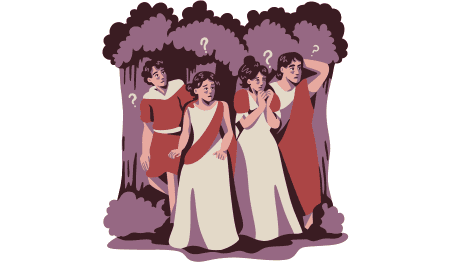
February is the shortest!
Have you ever wonder why February is the shortest—however the hottest! This is why: Good—and maybe big—things come in small packages; that’s what he said! Cooling down a little bit, let’s look into the real (and not-too-real) reasons behind February being the shortest-sexiest month it is.
February, with its sassy 28 days (and the occasional leap year adding that extra “je ne sais quoi”), has become the fashionista of the calendar lineup. Short, sweet, and always surprising, February—being once the last month of the Roman calendar—laughs in the face of those long-winded months.

The last shall be first?
That wasn’t exactly the case for February; it was, indeed, the last month of a shorter year during the times of Numa Pompilius, the second mythological king of Rome—Romulus’ successor. Remember Numa? Our guy from New Year’s in March? I am telling you dude; this guy Numa was everywhere—well, he was Rome’s king after all, right?
Alright, we need to take a trip back to ancient Rome to figure out why February is so different. Back in the early Roman calendar days, February—as mentioned—used to be the grand finale, the last hurrah of the year.
But, you know how it goes, things change over time, and the calendar had its own glow-up. Ready to continue walking on Romans sandals to better understand this conundrum? Hop on!

Roman Travel Machine!
It’s time to travel back to ancient Rome – think togas, sandals, and some serious calendar quirks. So, Romulus, the OG Roman legend, supposedly whipped up this calendar around the 8th century BCE. Picture it: 10 lunar months strutting their stuff, totaling 304 days. It was, of course, a lunar-based calendar.
They were playing this cool game of musical chairs with days, taking turns being 30 or 31, but winter? Winter just hung out like the cool kid with no assigned homework. He, winter, was literally hibernating. Chilly, right? No winter-specific months for those frosty vibes.
Now, continuing with our original question ¨Why February is the shortest? ¨. Let’s actually look into the not-too-real real reasons behind it: Roman superstition.

Nothing More Scientific than Roman Superstition?
Let’s blame it on Roman superstition – no high-tech reason, just some ancient beliefs making the calendar decisions. The Romans didn’t quite get the memo that “God doesn’t play dice with the universe,” you know?
They were doing their thing, making calendar decisions based on superstitions—and their lunar love—and not worrying about cosmic randomness. Who cares about those things when you are merely founding an empire? Exactly, they had better things to do!

An Even Legend!
One of the oldest legends connects February’s length to the Roman god Jupiter, who was considered the king of the gods. In Roman mythology, the idea was that Jupiter, who had been associated with the number 12, preferred an even number of days in a month.
Thus, February, the last month of the year in the early Roman calendar, was left with 28 days. But who knows, nothing more scientific than Roman superstition again.

Historical & Superstitious Reasons!
In reality, the reasons for February’s shorter length is not entirely clear, but historical theories suggest that it might be due to the Romans wanting to avoid even number of days for each month.
However, as February was the last month and all the days have been distributed among the other months, so February just took whatever it was left. So pretty much it came late to the party that couldn’t find many candies.

No even, No Steven!
So, back in ancient Rome, this guy Numa—and his advisers—had this thing about numbers and luck. They thought odd numbers were like little charms of good fortune, while even numbers were a bit meh, maybe even bad luck.
Now, the Romans—and our guy Numa, of course—were trying to figure out this calendar business, and they wanted the total number of days in a year to be lucky, meaning and odd number of days. But, here’s the twist – they had 12 months, all even numbers. So, they had to sneak in an even number of days somewhere.

Guess Who Got the Lucky Number?
February: Of course! Our boy February drew the short straw. It ended up with 28 days. Why? Well, they linked February with some serious business, like remembering the departed souls, which made it a bit unlucky. So, they gave it an even number of days to keep the whole year’s total odd, like a cosmic charm against bad vibes.
In a nutshell, it’s like the Romans saying, “Let’s balance out the luck, and make February a bit even to keep the whole year on the right side of fortune.” Weird, huh? Isn’t this confusing?

Numa: More Confusing than Confucius!
I know, we get it; this guy Numa is so confusing. I am tripping trying to understand all this superstition with this even and odd numbers thing. Let´s break it down for you: Numa Pompilius, back in the day, set up a calendar with 12 months.
Most months had either 29 or 28 days, but February kept it simple with 28 days. Now, if we do the math:
- 6 months with 29 days each: 6 * 29 = 174 days
- 5 months with 28 days each: 5 * 28 = 140 days
- February with 28 days: 28 days
Adding these up: 174 (from the 29-day months) + 140 (from the 28-day months) + 28 (from February) gives us a total of 342 days.
Now, the lunar year, the time it takes for the Moon to go through all its phases, is about 354 days. Numa realized he was a bit off, so he tossed in an extra month called Mercedonius. This month had either 22 or 23 days.
So, putting it all together, the corrected total for the Roman calendar would be 342 (from the 12 months) + 22 or 23 (from Mercedonius) = 364 or 365 days. There you go. That’s how they did it! Do you still don’t understand? It’s ok. I don’t understand either. I just pretend I understand it though. Let’s fast forward now to Julius Caesar’s time!

August Wanted What July Had!
Of course, he wanted it! If July had it, why not me? I am August, after all! Yeah, that’s exactly what happened. But let’s find out how it happened: You know that to get to the current calendar we went through a number of chaotic measures—and let’s be honest, very weird calendars—mostly based on Roman superstitious reasons.
We went from 30 to 29 days, during Numa’s reign to later get back to 30 to 31 days with the Julian calendar—and of course, February remained with 28 to 29 days. We will tell you next what happened to Julius Caesar’s calendar.

If July Has It, I want It!
The origin of February having 28 or 29 days is associated with both historical and legendary explanations. Another popular legend attributes it to the Roman emperor Caesar Augustus and his predecessor Julius Caesar.
According to the story, August wanted the month named after him—August for Caesar Augustus—to have 31 days same as July (Julius Caesar). To achieve this, he took a day from February, which at his time had 30 days.

Let’s Recap!
Historically, the Roman calendar underwent several reforms. The Roman calendar started with 10 months totaling 304 days, and the winter period was left unassigned. Later, January and February were added, but February was not initially given a fixed number of days.
Check out the concept of a Leap Year in our blog, where an extra day is added to February every four years. This was introduced by Julius Caesar in the Julian calendar reform. This adjustment was made to align the calendar year more closely with the solar year, which is approximately 365.25 days long.
While these legends provide interesting narratives, the true historical reasons may be a combination of practical considerations, attempts to align the calendar with astronomical events, and perhaps a degree of arbitrary decision-making during calendar reforms in ancient Rome. Now, that you know how February became the shortest, check our blog for more sexy stories like this one.

Sexy, Funny & Creepy Stories in Spanish?
Check out our sagas Things Spanish People Say in the Bedroom and el Sexy Chupacabras to learn dirty phrases in Spanish. If you like eerie stories, check out our Legends & Folktales section.
For a laugh, read our section Language Bloopers and learn from other mistakes when learning a new language. If wanna know more about Kasa De Franko, book a free lesson with us.

Red for Free
Yes, click on the red button to secure a spot for our next group lesson. If interested in a free private lessons, also click the red button. And always remember…

